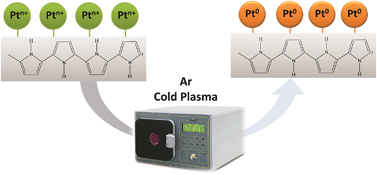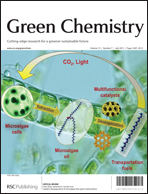Environmentally friendly reduction of a platinum catalyst precursor supported on polypyrrole†
Abstract
Supported metals are traditionally prepared by impregnating a support material with the metal precursor solution, followed by reduction in hydrogen at elevated temperatures. In this study, a polymeric support has been considered. Polypyrrole (PPy) has been chemically synthesized using FeCl3 as a doping agent, and it has been impregnated with a H2PtCl6 solution to prepare a catalyst precursor. The restricted thermal stability of polypyrrole does not allow using the traditional reduction in hydrogen at elevated temperature, and chemical reduction under mild conditions using sodium borohydride implies environmental concerns. Therefore, cold RF plasma has been considered an environmentally friendly alternative. Ar plasma leads to a more effective reduction of platinum ions in the chloroplatinic complex anchored onto the polypyrrole chain after impregnation than reduction with sodium borohydride, as has been evidenced by XPS. The increase of RF power enhanced the effectiveness of the Ar plasma treatment. A homogeneous distribution of platinum nanoparticles has been observed by TEM after the reduction treatment with plasma. The Pt/polypyrrol catalyst reduced by Ar plasma at 200 watts effectively catalyzed the aqueous reduction of nitrates with H2 to yield N2, with a very low selectivity to undesired nitrites and ammonium by-products.


 Please wait while we load your content...
Please wait while we load your content...